Where you see this button
Spider Collector's Journal (11th page: 2000-01) Copyright © 2005 by Rod Crawford
As explained on the first page, most of these notes of fun
(and not so fun) trips to collect spiders for research at the Burke
Museum appeared in Scarabogram, newsletter of "Scarabs:
The Bug Society," in their original forms. References to the editor
mean me; most other persons mentioned are Scarabs members. Dates of field
trips head each paragraph. Maps showing the location of sites within Washington
state follow the grid system outlined in the Washington
Spider Checklist. RETURN TO INDEX
Where you see this button ![]() in a
field trip account, click it to get a page of collecting site photos!
in a
field trip account, click it to get a page of collecting site photos!
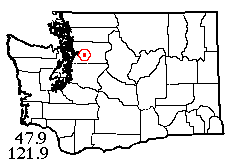 |
4 II 2000: My friend Della is normally as unencumbered with "wheels" as I am, but early this month she had a rental car for a few days to do some errands, and we decided to have an outing on February 4. Nearby spots where I haven't collected spiders are getting a bit scarce, but I picked an area of little-visited (at least by bug people) Cascade foothills, located north of Monroe (Stevens Pass highway) and south of Granite Falls. Right out in the "middle of nowhere," there is still plenty of suburban sprawl, but also farmland, a couple of county parks, and some state forest land to collect on. We had lunch and started collecting at Lake Roesiger Park, where the restroom buildings, leaf litter, moss from trees, and fern understory all yielded spiders. Then we drove to a trailhead leading into the state-owned forest of Three Lakes Hill. The area is closed to motorized traffic due to "poaching, littering, vandalism and harassment of wildlife" (apes will be apes, won't they?) and is a nice quiet place for a hike. While Della napped in the sun, I found a small marsh that had a few different spiders in the litter layer on top of the logs, then took a branch trail into a clearcut where there were some spiders on the young trees and under the stones of a gravel pit; on down the main trail, I came to the banks of a sizable stream where the leaf litter was made up of alder, maple, cottonwood and salmonberry leaves in about equal proportions. On the whole, spiders were a bit sparse compared to the previous (Dec. 30) trip, and I only got 25 species for the day, but it was a very pleasant outing for this sunny February, so no complaints.
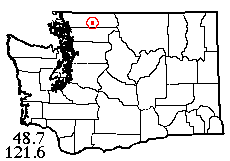 |
6 V 2000: On Saturday May 6, yr editor's friend Della had a hankering to soak in the hot mineral water at Baker Hot Spring, an undeveloped semi-natural site on the south flank of Mt. Baker. I went along to provide an escort (in case of bikers or other hazardous humans at the pool) and to collect some spiders. For a couple of hours, I sifted the rain-forest-like moss on the trees around the spring pool itself. Then I drifted back toward the trailhead (at a clearcut edge), sampling some vine maple litter along the way. At the trailhead itself, the habitat (alas!) even at this remote spot is being taken over by that nastiest of invasive exotic plants, the Himalayan blackberry! Nevertheless, enough spider habitat remains that I managed to sift spiders from cottonwood litter and beat others from conifer foliage. The planted Douglas-fir in the clearcut yielded very few, compared to the hemlocks along the edge of the forest. Time to go; but disaster strikes! A vial is missing, containing all the spiders from moss. Circumstances indicate it popped out of my belt in the vine-shrouded, rabbit-undermined jungle of the clearcut; no hope at all of ever finding it. Moral: must come up with a more secure way of carrying full spider vials!
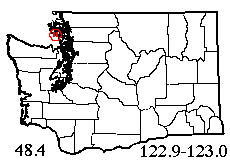 |
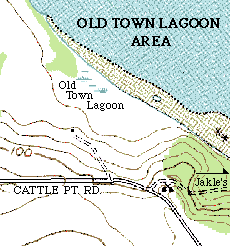 |
17-19 VI 2000: This is written on my first day back in the city after
going to Friday Harbor to do a one day spider class for the San Juan Nature
Institute. Transportation was by way of the Victoria Clipper, a high speed catamaran
which goes from Seattle and back daily, takes less than three hours, and compares
favorably in price with car plus ferry. On arrival I was met by Bill Agosta
of the institute, a retired chemical ecologist, who with wife Karin gave me
a tour of possible collecting sites. After checking Jakle's Lagoon, a popular
hiking destination in the Cattle Point area, and finding few spiders, I tried
a more primitive trail to nearby Old Town Lagoon which was much better. Then
the Agostas took me to their fantastic solar heated knoll-top home to collect
in the varied habitats (pond, meadow, deciduous and coniferous forests, and
rocky cliffs) on their property. Spiders were numerous. I haven't looked at
the catch yet but one interesting finding was a population of Tegenaria gigantea,
the "giant house spider," living in crack habitat on the cliff face
at least 250 m from the house. This island is closer to Victoria, the species'
original point of introduction to North America, so perhaps it has been there
long enough to undergo an adaptive shift away from the house habitat (it still
thrives there too, however).
Sunday morning,
the lecture part of the class went off well and we headed for Old Town Lagoon.
When we arrived it was too windy for good meadow sweeping (and remained so all
day) but we found good spiders in the conifers, the pitfalls I had set the previous
day, and the wetland meadow. Then we went to the adjacent beach to hunt for
the several jumping spider species that hunt on drift logs. We found 2 species
of these extremely attractive little spiders, the equally pretty wolf spider
Pardosa distincta, and the duller but still interesting Zelotes puritanus
in the same habitat, before the last student had to go home. Before my ride
arrived I had the chance to do more intensive collecting in more productive
habitats nearby. Even the wind was a blessing in disguise, in view of the presence
of voracious salt marsh mosquitoes!
I had intended to
be lazy on Monday until my boat departed, but one of my previous day's students,
Melissa Calohan (who creates cool
insect jewelry) hailed me walking down the street in town and invited me
up to her place in a third part of the island for more collecting. The habitat
at this site was badly encroached on by that nasty plant, the Himalayan blackberry,
but there was enough not yet covered to get good spiders from field grass, conifer
foliage, and a thick layer of moss growing on bedrock, plus a couple of impressively
large house spiders.
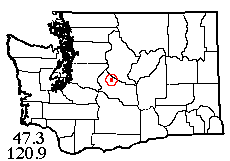 |
![]() 21 VII 2000: Visiting Finnish nature photographer Markku Savela had attended
a Scarabs meeting and wanted a guide to local habitats; I was glad to oblige,
since I'd get a new spider locality out of the deal. Considering the lateness
of the season and the mild winter past, I selected a fairly high site, but as
it turned out, not high enough. Liars Prairie in the area of the North Fork
Teanaway River is not too hard to get to if there's no snow on the roads. We
found signs that one drift had melted pretty recently, so we were hopeful, but
most of the butterflies at the site turned out to be too worn to photograph
well. Spiders were a bit sparse too, though there was one very interesting Antrodiaetus
specimen in a log, which Markku photographed. The site is very promising, with
a patchwork of varied meadows in mixed conifer forest, if one can just hit it
at the right season! To supplement the spider collection, we made 2 brief stops
at Jungle Creek and the banks of the Teanaway before calling it a day. You can
see many of Markku's excellent butterfly, plant, and miscellaneous arthropod
pictures at his
web site.
21 VII 2000: Visiting Finnish nature photographer Markku Savela had attended
a Scarabs meeting and wanted a guide to local habitats; I was glad to oblige,
since I'd get a new spider locality out of the deal. Considering the lateness
of the season and the mild winter past, I selected a fairly high site, but as
it turned out, not high enough. Liars Prairie in the area of the North Fork
Teanaway River is not too hard to get to if there's no snow on the roads. We
found signs that one drift had melted pretty recently, so we were hopeful, but
most of the butterflies at the site turned out to be too worn to photograph
well. Spiders were a bit sparse too, though there was one very interesting Antrodiaetus
specimen in a log, which Markku photographed. The site is very promising, with
a patchwork of varied meadows in mixed conifer forest, if one can just hit it
at the right season! To supplement the spider collection, we made 2 brief stops
at Jungle Creek and the banks of the Teanaway before calling it a day. You can
see many of Markku's excellent butterfly, plant, and miscellaneous arthropod
pictures at his
web site.
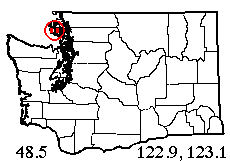 |
9-10 VI 2001: The second year's spider class for the San Juan Nature Institute was just as successful as the first, and featured some bonus spider collecting as well. Kathleen McDanold (SJNI) picked me up at the Victoria Clipper dock on Saturday and we went to check out sites for the class field trip. We soon settled on the English Camp area which has some nice oak savanna near their historic cemetery, plus a big grassy field and typical San Juan Island conifer-madrona forest. Then she dropped me off at a site where I needed to do some fill-in collecting, on a seemingly unnamed peninsula extending southeast from the "other side" of Friday Harbor. Right in the center of this peninsula, maps showed a good sized tract of undeveloped land, with a wetland right in the middle. This turned out to be a marsh and extensive wet grassy meadow, surrounded by lodgepole pine - Douglas-fir forest with reproduction of both species; also an alder grove. A few hours' collecting there produced 29 spider species, the highlight being a new species of the moss-living cobweb weaver Robertus. The class the next day went fine, and we saw typical oak litter and grassland spiders with lots of wolf spiders down below in the big field.
This page last updated 7 April, 2024